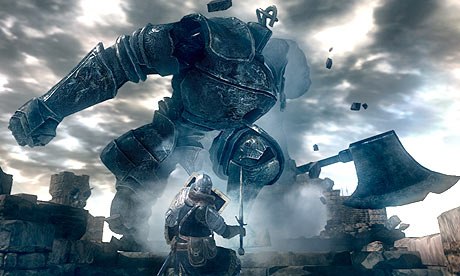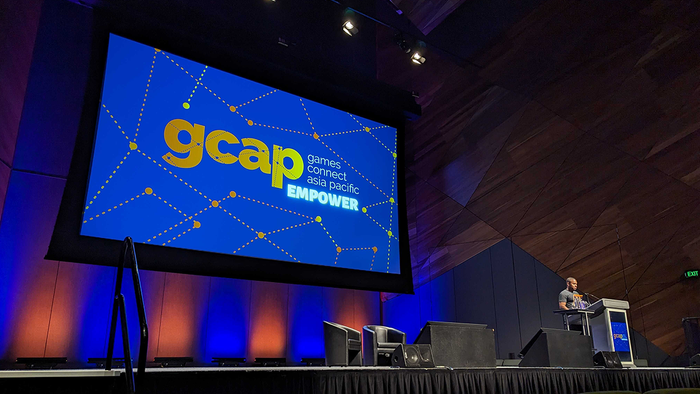
Featured Blog | This community-written post highlights the best of what the game industry has to offer. Read more like it on the Game Developer Blogs.
How To Reinvigorate Learning By Using Play
Everyone has a job—for the youth, it is to attend school, where performance is routinely, numerically measured by standardized tests in order to compare them with their counterparts across the nation. There is no room for fun... or so we thought.

More than once everyday I wonder why school is boring when it should be exhilarating and engaging; why people thought skipping class was cool rather than foolish; why I could often learn more at home than in the classroom. The problem is that we live in a post-industrial society; as education is responsible for the economic, social, and political development of any such society, it embodies the performance-based curriculums of the industrial era. Everyone has a job—for the youth, it is to attend school, where performance is routinely, numerically measured by standardized tests in order to compare them with their counterparts across the nation. There is no room for fun—play is for children. Play is the opposite of work. A 2004 study reported gamers aged above 32 having problems believing games could be “purposeful”—with such low morale towards play even in gamers, it isn’t a surprise that educators view play and instruction separately (Miller). As such, anything non-lecture based is labeled as an “extra-curricular”. Play doesn’t fit into the equation…
…Or so people thought. Game designer turned lecturer Lee Sheldon is a professor at the Rensselaer Polytechnic Institute whose gamified classroom caused perfect attendance and boosted the average grade from a C to a B (Plenda). School has all the necessary mechanics of a game: scores, leaderboards, rules, tasks, and incentives. Teachers have the capacity to become game designers. Play may be the opposite of work, but it is definitely not the opposite of learning—creating a classroom where learning is playing and vice versa would make education fun, eliminating the problems of low attendance, half-hearted participation, and procrastination.

The concept of play and learning as parallel lines running in opposite directions is only a figment of the imagination—play is a mode of interaction deeply involved with and essential to learning. Biologically speaking, natural selection only privileges useful traits—thus, play is useful. The existence of the human race itself is attributed to play—imaginative play develops the ability of hypothesis. The ability to foresee new possibilities is what allowed humans to exploit different environments and resources. Play develops exploration, determination, and creativity—these traits are what brought us the Internet and allowed us to reach the moon. To picture the usefulness of play on a smaller scale, imagine two lion cubs play-fighting. Their actions mimic that of a real fight, but both know that they are “at play”. In this setting, play is a form of meta-communication that developed before spoken language in order to create a sphere allowing experimentation and growth (Salen and Zimmerman). Experiments on American preschoolers have shown that even 3 year-old children can distinguish between real life and pretend, and use information from pretend to understand the real world. Without play, a major chunk of development is eliminated, not to mention the numerous chemicals beneficial to brain cell growth produced during play (Dewar). Decreasing play in education is therefore clearly, unmistakably, 100% illogical.
But of course, humans love doing stupid, illogical things. It is impossible to go through ten pages of a history textbook without encountering a paragraph containing some act of stupidity. The current state of education will be that paragraph in future textbooks (or, eBooks); during my time in high school and college, I have never witnessed full attendance in classes that don’t have roll calls. There are General Education classes I attend in which the classroom is half empty during lectures and packed during assessments. There are instances where a dozen others and myself pen the sign-in sheet and leave immediately. Other than that one over-zealous student who even annoys the professor, not one person actively participates. And with no self-motivation, students wait till the last moment to complete assignments; research has shown that procrastination has more than quadrupled in 30 years, 95% of university students admitting to procrastination problems. 43% of students admit they procrastinate because they do it so often it has become natural to them (Gaille). 6.4% of college students in the US admit to using Adderall to help them focus (Adderall & College Students). These issues of chronic absence and procrastination are not because students hate learning, but because the lectures aren’t engaging and there is no intrinsic motivation to succeed in the particular class. It’s surprising to realize that the current method of education has gone unchanged for hundreds of years! Attempts to solve motivation issues have always been teacher-centric—but play is the only mechanic that encourages students to motivate themselves. The classes with the largest amounts of motivational problems are those without elements of play.
Then, take a class that has been gamified, such as the classroom of the aforementioned Lee Sheldon—lack of motivation is no longer an issue. Lee, a former, designer of MMO (Massively Multiplayer Online) games, molded his classroom into a game world, reminiscent of pastimes like Warcraft and Everquest. Students created avatars and formed guilds and clans; instead of completing assignments, students initiated group “quests” and solo “missions”. The most notable difference is the grading system, which implements an RPG-like experience points system rather than a traditional letter grade system. Students begin with zero XP (experience) points and level up through completing quests and missions. The final amount of experience determines student ability in Lee’s class and difference incentives such as extra credit or even physical badges offered to students who reach a certain level before others do (Sheldon). In the gamified classroom, students are motivated—an extremely important facet of learning. A bad student with an excellent teacher is worse off than a motivated student. Sheldon’s method works because it is natural—play is a major component of learning because it engages players emotionally, cognitively, and socially. Games demand players to solve problems and experiment. According to research published by the Gates Foundation, over 80% of teachers in gamified classrooms agree that games have improved student mastery of curricular content, and over 70% agree that games improve critical thinking and communication skills (The National Survey of Digital Game Use Among Teachers). With clear rules and rewards, players (or, students) become more motivated to achieve; the experience point system allows room for failure so that players can improve their skill until they beat the level. They are not punished for making mistakes, but are rewarded for learning the material. Failure is no longer a fear but an accepted process in order to learn the rules and skills in order to proceed. The gamified classroom works because there is no fear, drudgery, or tedium, but actual learning leading to a sense of accomplishment. As an added bonus, this new instructional method is cheap, requiring no extra equipment at all.
Lee Sheldon’s method has been adopted by numerous educators, with each adaptation adding their own little twists to the mechanics of the MMO classroom. For example, many teachers choose to use computer games rather than follow Sheldon’s model of an MMO classroom. Even outside of the classroom, gamification has made its debut—the popular productivity app, EpicWin, bestows rewards RPG-like prizes to users for completing real-life tasks.
Mundane tasks become fun, once completing them awards mystery prizes like “The Tattoo of Incarceration” which can be equipped to the user’s fantasy avatar, or humorous quips that brighten the user’s day. There are numerous other mechanics in this app and many others that are perfect for the Scott Piligrim generation (in fact, I will earn 300 experience points for finishing this essay), but how can the gamified classroom be properly implemented to enhance education, and not just be reminiscent of the occasional game of Jeopardy in middle school history class? For successful integration, games must be the primary focus with learning as causality, in contrast to the traditional classroom where games are only assignments masked as something “fun” (e.g. chocolate-covered asparagus). The effect teachers aim to achieve is to have their students enter a state of flow akin to that of a gamer who can play for hours on end. Any successful game that can initiate flow taps into the cognitive, emotional, and social systems of the player.

The popular mobile game, Angry Birds (a game where you sling birds to destroy towers), is an example of cognitive utilization—players experiment with the different physical properties of tower materials, the elasticity of their slingshot, and the ability of each bird in order to topple their objectives. Each level is short and features a different puzzle, levels increment in difficulty, and there is an immediate score displayed at the each level (the score depends on what method the player chose to finish the level). Applying these game mechanics to schools has many benefits, the most apparent being motivation. In school, students are asked to do work with no immediate results other than a letter grade—they do not see the benefit of the work in the long run, and lack passion to do it. Games allow players to implement knowledge they learn immediately in order to pass a level, and thus students can see the immediate progress of their work. Activities that challenge the student and allow them to solve the problem in their own manner with non-vague, immediate rewards, is much more fulfilling and tantalizing.

Emotion, another instrument in the toolbox of game design is central to gamifying a classroom, as negative emotional experiences must be translated to positive learning experiences. School is a high-stress environment where the stakes of failure are high because curriculums have few opportunities to be assessed—thus, students feel fear and anxiety in school rather than more positive emotions. The idea of failure in games, however, differs greatly—it is not a something to be afraid of, but simply another gameplay mechanic. The game Dark Souls is an RPG famed for its difficulty—in fact, it has been labeled as “unfair”, “masochistic”, and “a sadistic, unforgiving taskmaster”. The margin for error in executing certain moves can be under a tenth of a second; the player avatar is weak and fragile, often dying from a single monster attack; often there are no ways of foreseeing your own death—bridges will collapse and giant, Indiana Jones inspired boulders will roll and smother—the player is left with no choice but to replay the level. Yet, this masochistic game with its dark color palettes, zombies, and ghouls has been called “educational”, “friendly”, and “the most benevolent game of its generation” (Houghton). Although the game is brutal, it is not unforgiving—the player develops a relationship with failure because it is a necessary tool to proceed. The unsuspecting player must first be killed by the falling bridge in order to know (on the next playthrough) to find an alternate path. Failing repeatedly in Dark Souls is the only way to synthesize new information to win. A gamified classroom maintains short feedback cycles to keep stakes low and transform failure into an integral part of learning instead of a factor causing helplessness or fear. Students wouldn’t have incentive to put tasks off or avoid school once learning is no longer overwhelming or daunting.
Outside of the set curriculum, students must also learn skills such as communication and teamwork. Games allow players to take on different roles and make decisions based on these roles and their new points of view—this mechanic is not only a fun role-play but helps students who feel they are not adequate for school realize they are actually making progress (through short feedback cycles rather than scaring them with high-stakes failures). Existing in different roles can also allow younger students to explore different parts of their psyche to better understand who they are or develop new skills, such as leadership development in a shy child. Playing games together can also develop camaraderie and friendship; even outside-of-game activity such as classmates high-fiving each other can build teamwork and relationships as students compare scores and in-game decisions. Recognition of scores or achievements could be broadcasted in digital games or by the teacher. The positive reinforcement of school can shape how students think of themselves and what school really is: not a place of boredom and trying to find a spot in the cafeteria, but a place to learn, have fun, and make friends.
Gamification is the only method towards improving education that empowers students to become self-motivated scholars. There is no guarantee that all gamification projects will succeed—students may become too obsessed with rewards and game achievements, teachers may fail to design fun and engaging curriculums—but new modes of teaching cannot be expected to succeed across all attempts of implementation. Despite this risk, instilling play in the classroom is a worthy pursuit—removing the fence between formal and informal learning is the first step in creating intrinsic, lifelong motivation to understand and create.
LEVEL COMPLETE! +300EXP
Works Cited
"Adderall® & College Students." Adderall and College Students. SAMHSA, May-June 2009. Web. 09 Nov. 2014.
Dewar, Gwen. "The Cognitive Benefits of Play: Effects on the Learning Brain." The Cognitive Benefits of Play: Effects on the Learning Brain. N.p., 2008. Web. 10 Nov. 2014.
Dobbs, David. "Playing for All Kinds of Possibilities." The New York Times. The New York Times, 22 Apr. 2013. Web. 10 Nov. 2014.
Gaille, Brandon. "17 Lazy Procrastination Statistics - BrandonGaille.com." BrandonGaillecom. N.p., 2013. Web. 09 Nov. 2014.
Houghton, David. "Why Dark Souls Is the Friendliest, Most Benevolent Game of Its Generation | GamesRadar." Why Dark Souls Is the Friendliest, Most Benevolent Game of Its Generation. Games Radar, 5 Mar. 2014. Web. 10 Nov. 2014.
Miller, Christopher T. "Play." Games: Purpose and Potential in Education. N.p.: Springer Science and Business Media, 2008. 2-5. Print.
The National Survey of Digital Game Use Among Teachers. "Survey: Teachers, Games and Assessing Students." Games and Learning. Bill and Melinda Gates Foundation, 2013. Web. 10 Nov. 2014.
Plenda, Melanie. "Are Multiplayer Games the Future of Education?" The Atlantic. Atlantic Media Company, 11 July 2014. Web. 10 Nov. 2014. <http://www.theatlantic.com/education/archive/2014/07/are-multiplayer-games-the-future-of-education/374235/>;.
Rieber, Lloyd P., Lola Smith, and David Noah. "The Value of Serious Play." The Value of Serious Play. The University of Georgia, 1998. Web. 10 Nov. 2014.
Sheldon, Lee. "ATLAS Speaker Series: Designing Coursework as a Game." YouTube. University of Colorado - Boulder, 12 Apr. 2012. Web. 10 Nov. 2014.
Sheldon, Lee. Gamification in Education: What, How, Why Bother? Gamifying Education. Columbia University, 2011. Web. 9 Nov. 2014.
Tekinbaş, Katie Salen., and Eric Zimmerman. The Game Design Reader: A Rules of Play Anthology. Cambridge, MA: MIT, 2006. Print.
Whitton, Nicola. "Games for Learning: Creating a Level Playing Field or Stacking the Deck?" International Review of Qualitative Research 6.3 (2013): 424-39. Ascilite. Manchester Metropolitan University, 2007. Web. 9 Nov. 2014.
Read more about:
Featured BlogsAbout the Author(s)
You May Also Like







